I have seen the artist’s watercolour paintings from previous shows, but I have never been amazed and impressed until today. The paintings departed from a mere piece of decoration and transformed to a mature, confident, and technique-based work of art. This exhibition showed variations of themes, from sea and landscapes, still-life’s, to social and cultural representations of people in the villages. The watercolours possessed the artist’s growth in using the medium, from a controlled palette to a more fluid and spontaneous use of colour pigments and wash. The exhibition is at Artshine @Yuga Café & Gallery in Glebe, will run until the 24th of March.
As the title suggests, the compositions are the artist way of capturing the beauty and grandeur of the cities and towns she visited over the years. The places are so varied that a sense of longingness to see them lingers in the gallery. The watercolours were bright, airy and lighthearted, a joyous attitude perhaps of the artist, when these were made. In 2016, Helen had a solo exhibition that captured Asia and the painting Paradise I believe can be said as a remnant of that show. The interplay of bright colours contrasted the interplay of cerulean and cobalt blue inspired foreground. The painting is flat and busy. It confuses the eye but perhaps the sunrise in the background brings cohesion since it invites the viewer to focus on the canary yellow pigment in the middle of the picture. The use of the lotus leaves and flowers are quite significant in this painting. Most Asian paintings inhere this type of vegetation because it signifies resilience and beauty. From a ‘muddy’ environment comes life, vitality and growth and such message cannot be denied when looking at this painting.
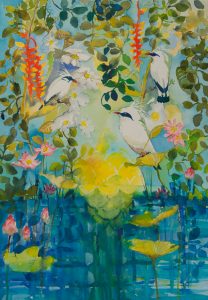
Watercolour on paper
74.0 x 64.0 cm
AUD 750
Departing from the last painting, For You uses the Lotus flowers again this time covering two-thirds of the whole paper. What struck me most about this painting was the gentility of this flower, being compared to the innocence and tender stature of the child in the painting. With a cheeky smile, the flower on his left hand and the paddle on the other to keep his balance, the composition was transformed to something that is personal and conversational. The division between the foreground and the background provided perspective. Rather than staying flat, the artist provided the foreground with a foreshortened view of the raft. This technique was used centuries ago to provide depth to a painting. Such caution was given to its depiction to express the pliability and sensitivity of the raft, but also to lead the eye to focus in the centre where the whole composition was based on.
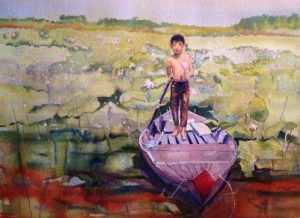
For You – CAMBODIA
Watercolour on art paper
44.0 x 57.0 cm
SOLD
Mariner’s Wharf follows the same technique of foreshortening mentioned above. The congregation of fishing boats were facing towards the viewers instead from its sides. This representation follows academic elements due to its flow of viewpoint from the bottom of the painting to the top with the appearance of the horizon line giving that three-dimensional marking.
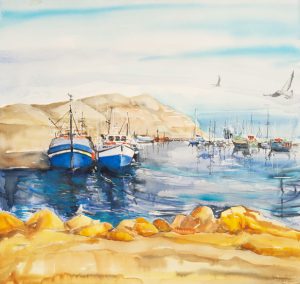
Mariner’s Wharf – SOUTH AFRICA
Framed Water colour on art paper
68.0 x 63.0 cm,
SOLD
From the conversation I had with the artist before the opening of the exhibition, I asked her why she became interested in watercolour instead of other popular mediums such as oil. She commented that she tried all other mediums but did not like the restricted and regimented process of them. She said that with watercolours, there’s more freedom and resides a free-spirited attitude in art. The effect of washes of colour pigments on a crisp white paper excites her. She said that it is always challenging to produce a result with watercolour paintings since the colour pigments would have seemed to possess a mind of its own. That one can only predict its result once you grasp its nature and presence. As I see it, it’s a relationship between the artist and his or her chosen medium. This relationship embodies the style of the painting below entitled Street Scene. From the very first time I saw it in the exhibition, I felt its authenticity. The spontaneity of her brushstrokes and washes did not hide anything. The accidental blemishes produced by the washes appeared to be raw, organic and pure. The artist stayed true with what she saw. No embellishment, just sincerity. And this consistency in style is apparent to her other paintings like Garden Gate, Red Bridge, and Japanese Bridge.
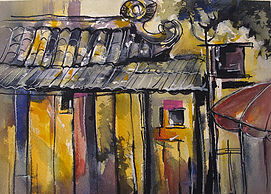
Street Scene – Ha Noi, VIETNAM
32.0 x 40.0 cm, Watercolour on art paper
AUD 250
The presence and representation of people in street scenes were the most popular and photographed in the recently held Victorian Watercolour Exhibition at the Art Gallery of NSW. The exhibited watercolour paintings of everyday people brought cultural and social construct during the 19th Century in the Victorian era. I cannot help but to compare the paintings of Publio de Tommasi, The Game of Chess, Charles Robertson’s Bazaar Gossip and Sir Ernest George’s San Gimigniano to these paintings that I see in this exhibition. Although not grand in scale and a postulant in representation, the paintings Morning Stroll and Another Day nevertheless, evoke the same character and quality. The continuous interplay of warm tones, its perspective and the uninhibited representation of reality all formed a cohesive picture. It is like a harmony that can be felt and but barely seen.
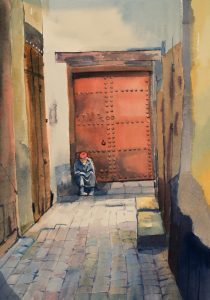
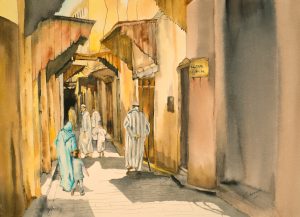
Another Day Morning Stroll – Marrakesh, MOROCCO
Watercolour on art paper Watercolour on paper
30.0 x 41.0 cm Sold 31.0 x 42.0 cm Sold
The paintings presented in this exhibition embody the artists love of travel, nature and art. The attitude of capturing short moments and laying them directly on paper evokes a sense of wonder that a viewer can actually feel. Combining this with good techniques and educated approach in the medium of watercolour, most of the time, it results to more than beauty. The paintings I see here today seeks more than appreciation. It invites a relationship seeking conversation, between the viewer and painting. This transcends the superficiality of the need to acknowledge the artist. It is not about them, it is about the art. In which I know Helen would not mind.
About the art historian and writer – Norman Domigpe

My name is Norman Domigpe, and I love anything that is related to art. Since being very ‘artsy’, I tried everything when I was little. Tried dancing, failed. Singing, failed. Played the piano and violin, failed. Painting, failed. But the history of art intrigued me big time, so I started collecting and writing about art. I believe that art is the only medium that affects all the senses.
I am undertaking postgraduate studies under the program, Masters of Art History from The University of Adelaide. I finished a graduate diploma course on Art History from the Art Institute London and attained an undergraduate degree in Psychology.
I am a member of The Art Association of Australia and New Zealand, the national professional body for art historians. Member of the Art Gallery Society of NSW, National Art Gallery in Canberra, The National Gallery of Victoria and The Art Gallery of South Australia.
As a writer, I have written reviews on Aboriginal, Australian and Contemporary Art and I contribute some of my works to ArtShine Gallery.
You will see me around, especially on exhibitions. Would love for you to say hi.

